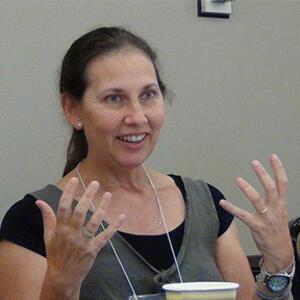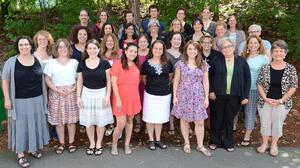Lessons from Suzin Glickman, z”l
I haven’t attended synagogue regularly as an adult, and so I have rarely said the Mishebeirach prayer—a prayer for the healing of the body and spirit. However, when I started to get more involved in Jewish ritual about a year and a half ago, I started to say the prayer for a friend and colleague of mine, Suzin Glickman. I said it because Suzin was sick, but also because I knew she would totally dig that I found a Jewish ritual that felt meaningful to me, and found a way to make it my own. At the end of January, Suzin lost a long battle with cancer. For the first time in my life, I said the Mishebeirach one day and the Kaddish, a Jewish prayer for mourners, the next. I felt sadness and loss like a tight knot down in my kishkes (Yiddish for guts).
I first met Suzin Glickman face-to-face on an elevator at the Sheraton Needham. She and I and a few other women were standing in awkward silence, trying not to make eye contact, when I said, “Are any of you here for the Jewish Women’s Archive Institute?” They said yes, and we immediately introduced ourselves, laughing at the human tendency to avoid others in elevators. Although it was the first time we’d met in person, I felt like I was seeing an old friend. Suzin started brainstorming a million ideas the moment she introduced herself, a trait I recognized from the hours we had already spent on the phone discussing her class, her curriculum, her views on Jewish education, and the role of Jewish women in social justice history.
One of the things I admired most about Suzin’s teaching style was her edge. She reveled in taking risks, pushing the envelope, and asking her students to go out of their comfort zones. Her classes like “It’s Legal, But is it Kosher?” and “The Bad Girls of Canaan and Brothers Behaving Badly” asked students to examine tradition and debate it, question it, and apply it to their own lives. Her lesson on sweatshop labor included documents from women factory workers, a video on unfair labor practices in iPad factories, and a simulation where students had to tie fleece blankets in a certain amount of time (to be donated to a local shelter). She wanted students to “critically examine the news, not passively take it in,” and so she had them reflect on current events and connect it to the Jewish stories they had learned.
As a young professional, I have sometimes struggled to find my place in a field that has been dominated and led by educators who have been teaching for more years than I have been alive. Especially at the beginning of my tenure at JWA, people would be surprised by my age, and sometimes skeptical of my ability to do my job well. But not Suzin. Suzin understood that teachers can be found anywhere if we are always open to learning. If I emailed her with a quick question, nine times out of ten my phone would ring seconds later—Suzin had some follow-up questions and a lot of ideas and it was just easier to discuss them over the phone. If she had an idea she was working through, she would shoot me an email and say, “Hey, whaddya think?” She trusted me as a teacher, treated me as her equal, and challenged me when she felt there was more I could be doing. Her openness and candor helped me see myself as a leader and her gentle challenges taught me that it was okay not to know everything—and even better—to ask my colleagues to help fill in the gaps.
In my four years as education program manager, I have met hundreds of Jewish educators who are working hard to create purposeful, meaningful learning experiences for their students. But Suzin did even more. Suzin was a champion. Though we weren’t extremely close, Suzin taught me some of the most important lessons I have learned as an educator. In her honor, I will share a few of these gems with you. May her memory be a blessing to us, to our students, and to the inclusive, dynamic Jewish community Suzin dedicated so much of her life to building and shaping.
Lessons from Suzin Glickman:
1. If you have a question, ask it. If you have something important to add to a conversation, share it. Quieting yourself limits what you can learn and what you are able to teach to others.
2. Learning happens when it matters to us. A teacher’s job isn’t to dump knowledge into minds. Instead, a teacher should encourage students to be critical thinkers, and help them weave seemingly disparate or conflicting ideas into a cohesive and meaningful whole.
3. The best teacher is also a student. We can never be happy with what we already know. Instead we must hunger for new knowledge, seek out opportunities to engage with new ideas, and be open to learning from anyone, anytime, anywhere.








Hi Etta, my name is Abbie and I am Suzin's daughter. I just wanted to tell you that I often come back to this article because it makes me so happy. I love the way you write about my mom and I want to thank you so much for this piece, it means a lot to me.